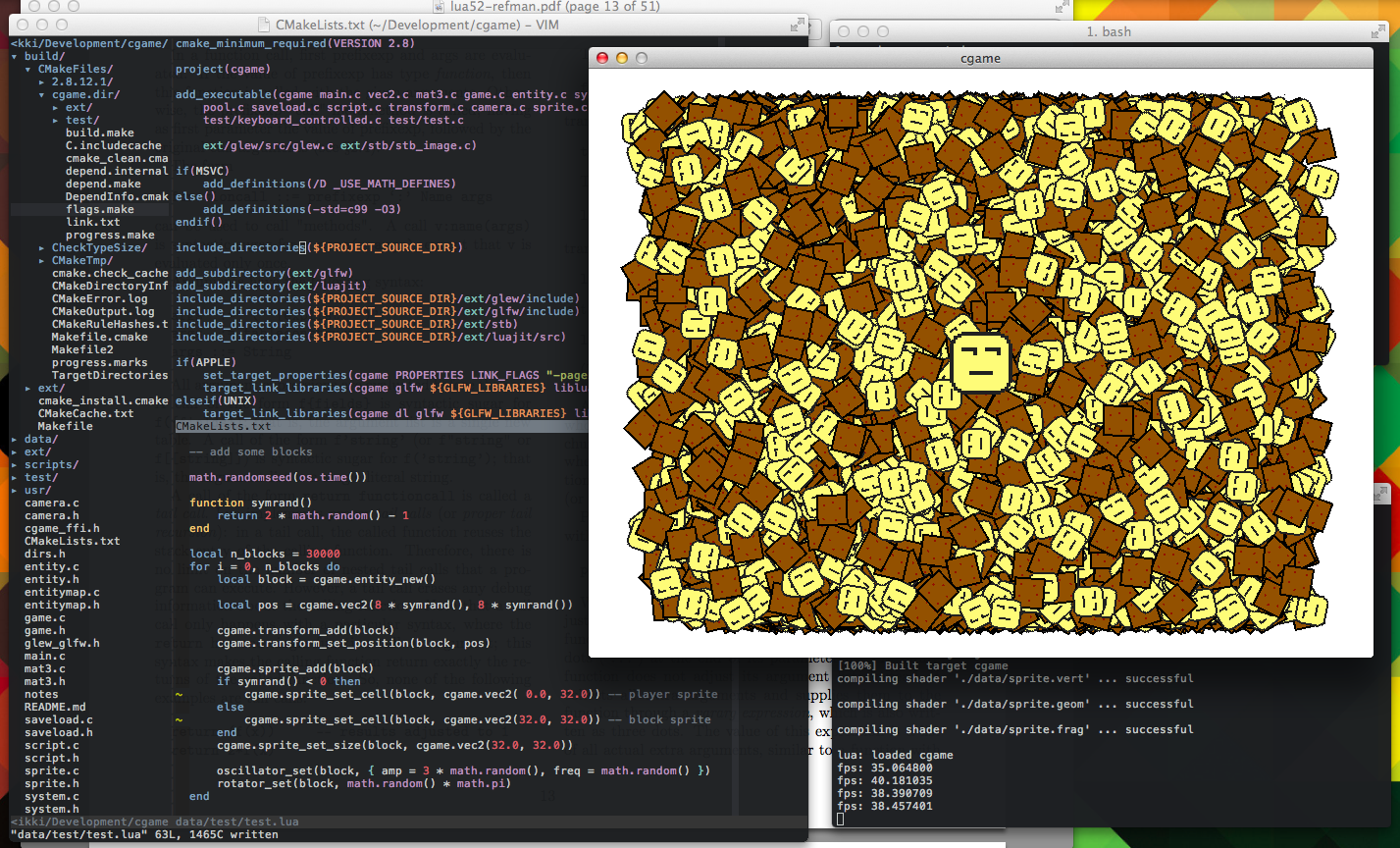cgame: C entity-component-system, 2d sprites, Lua scripting, save/load
My last blog post was about sprites in modern OpenGL. I realised that the whole 'sprites are POD structs contiguous in memory' idea lent itself to an entity-component-system model -- you just store all the sprites for every entity in this huge array. Transform, physics object and whatever other component works this way too. The game data is just a bunch of tables and an 'entity' is just a primary key like in a relational database.
So I decided to try it out. Started with the sprite and transform components, then added save/load and also Lua scripting.
In the picture above you see a test run with 30,000 entities each in 'oscillator' and 'rotator' Lua systems that move them around. My Macbook Air can handle the above at 40fps. You can see the Lua script that makes the blocks in the bottom-left of the screen.
The code's on github here. I've tested it on Windows and Mac OS X. Needs OpenGL 3.2 to work.
Save/load was easy to implement because each system just serializes/deserializes its own table. So the save/load isn't entity-centric, it's system-centric -- you don't iterate through entites and save each one, instead you just save the various tables and it all works out because of the primary key consistency.
The whole engine is exposed to Lua script. Making the player entity you see in the middle of the window was as simple as,
local player = cgame.entity_new()
-- put it in the 'transform' system so it can move, rotate
cgame.transform_add(player)
cgame.transform_set_position(player, cgame.vec2(0.0, 0.0))
cgame.transform_set_scale(player, cgame.vec2(2, 2)) -- twice as big
-- put it in the 'sprite' system so you can see it!
cgame.sprite_add(player)
cgame.sprite_set_cell(player, cgame.vec2( 0.0, 32.0))
cgame.sprite_set_size(player, cgame.vec2(32.0, 32.0))
What's fun about the systems idea is if you wanted to control it by keyboard you just add,
cgame.keyboard_controlled_add(player)
But if you wanted to control the camera by keyboard instead, just replace 'player' with the camera entity in the above line. Cameras work through systems too -- just put anything that also has a transform in the 'camera' system and the game is rendered from that viewpoint with rotation and scale (scale is zoom). Not just add entities you can create systems in Lua too. Here's the code for the rotator system:
local tbl = {} -- tbl[ent] contains data for ent -- right now just speed
function rotator_set(ent, speed)
tbl[ent] = speed or 2 * math.pi
end
cgame.add_system('rotator',
{
update_all = function (dt)
for ent, speed in pairs(tbl) do
cgame.transform_rotate(ent, speed * dt)
end
end,
})
The Lua script system uses LuaJIT. This makes it pretty easy to bind C functions to Lua through the FFI library. All symbols exported from the executable are available from LuaJIT, you just have to give it the C prototype. MSVC doesn't export symbols by default so you need __declspec(dllexport) there. cgame's script.{h,c} does some magic that makes this really easy -- you just need to surround your declarations in C with 'SCRIPT(modulename, ...)' and add an 'EXPORT' in front of functions. Here's some examples from vec2.h and transform.h:
SCRIPT(vec2,
typedef struct Vec2 Vec2;
struct Vec2 { float x; float y; };
EXPORT Vec2 vec2(float x, float y);
EXPORT Vec2 vec2_add(Vec2 u, Vec2 v);
/* ... */
)
SCRIPT(transform,
EXPORT void transform_add(Entity ent);
EXPORT void transform_remove(Entity ent);
/* ... */
)
This also acts as a normal C declaration when #included into other files, which means there is no duplication. The actual declarations look like the above and the cgame module in Lua is always up-to-date. You can continue adding C functions normally and they'll be visible from Lua. The FFI library also allows wrapping C structs. This allows, for example, the '+' operator for Vec2 in Lua (binds to 'vec2_add(...)') or any other extensions that are easier to write in script.
